Shipping is largely ignored by most and yet absolutely fundamental to our global economy. Over 80% of goods are carried by sea and the world merchant fleet totals about 50,000 ships, and the only reason I know this is because I co-founded Shone, a startup focused on shipping technology.
Almost every day I learn something new about shipping, but one of the things that still shocks me to this day is something I read in August of last year: the 15 biggest ships pollute as much as all the cars in the world.
To make this clearer, it means that 15 ships = 750M cars in terms of pollution.
To be honest, this statement is slightly misleading as it only takes a specific type of emissions into account. Regardless though, shipping does pollute a lot! Fortunately however, the industry has recently passed new laws that will reduce its environmental footprint consequently. So let’s take a closer look.
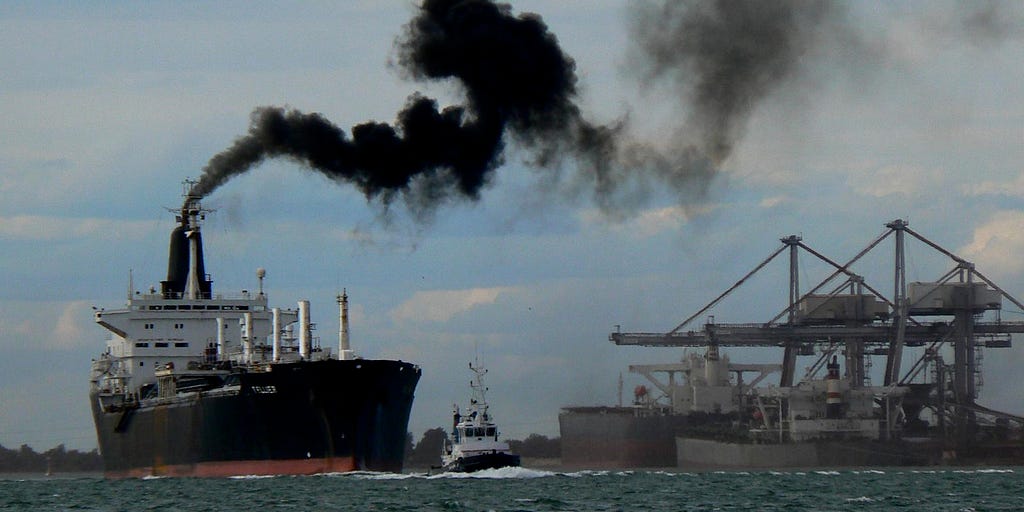
Sulphur oxides and nitrogen oxides
Let me start by clarifying the sentence above. Actually, the 15 biggest ships generate as much sulphur oxides (SOx) as all the cars in the world. Shipping is actually responsible for 13% of annual SOx emissions worldwide.
Ships also emit nitrogen oxides (NOx) in large quantities and shipping accounts for 15% of global NOx emissions.
This means that shipping is emitting more NOx than the US and India, and sits just below China. To visualize this, here is how much shipping emits in terms of SO2 and NOx compared to China, the USA, India, Russia and the aviation industry. Note that SO2 is one of the major pollutants of the SOx family.
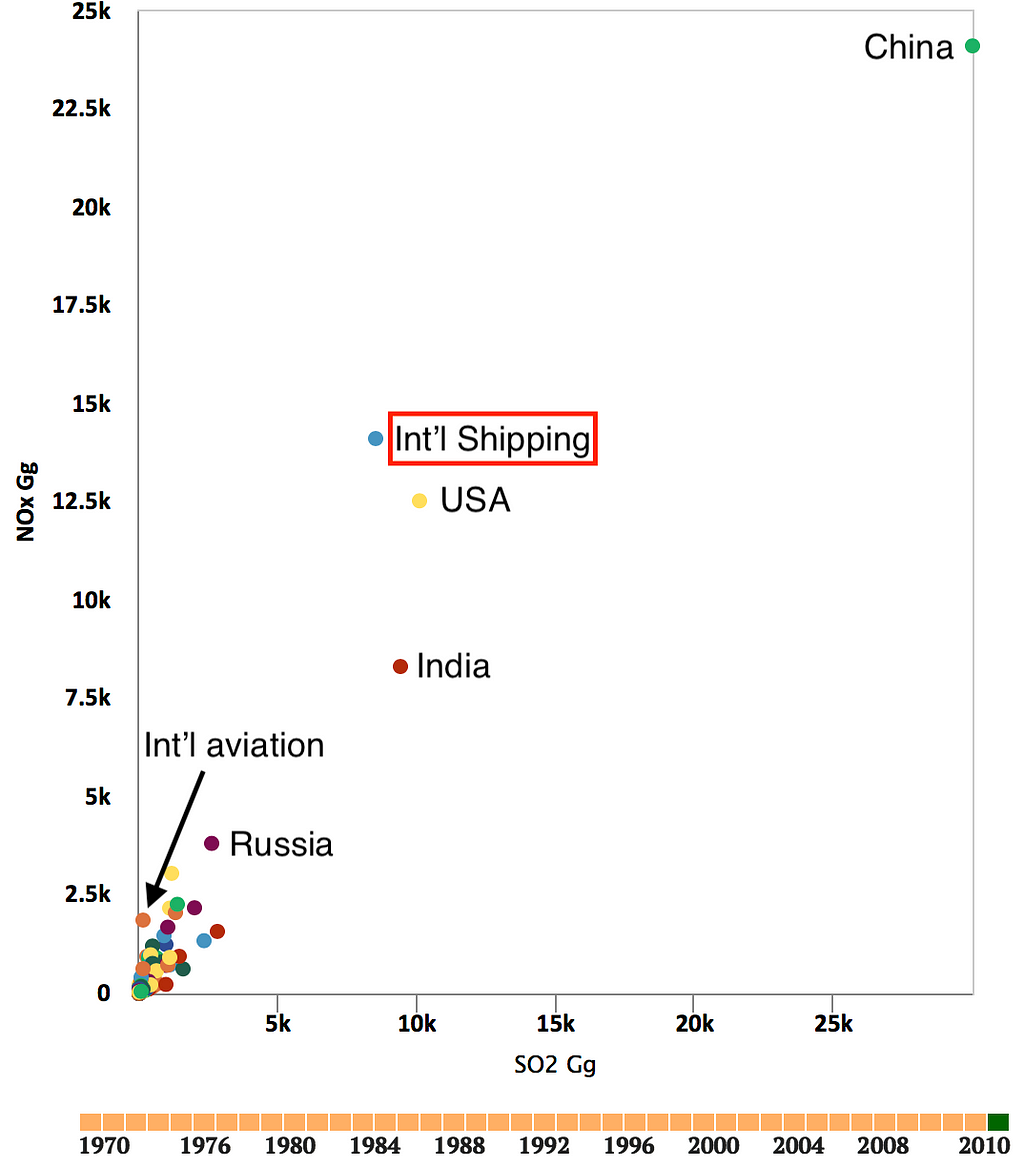
Ok, so should you care about these emissions?
A quick look at EPA’s website shows that:
- SOx and NOx can harm the human respiratory system and make breathing difficult
- SOx and NOx react with other chemicals in the air to form both particulate matter and ozone.
- SOx and NOx can contribute to acid rain which can harm sensitive ecosystems
So it’s safe to say that we are collectively better off with less of those in the air!
CO2 emissions
But ships also emit more classic greenhouse gases! Indeed, shipping is reponsible for ~2.6% of global CO2 emissions. To put things in perspective this means that if shipping were a country, it would be the sixth biggest carbon polluter (between Germany and Japan). Even worse, shipping-related emissions are on track to soar by as much as 250 percent by 2050 as global trade expands
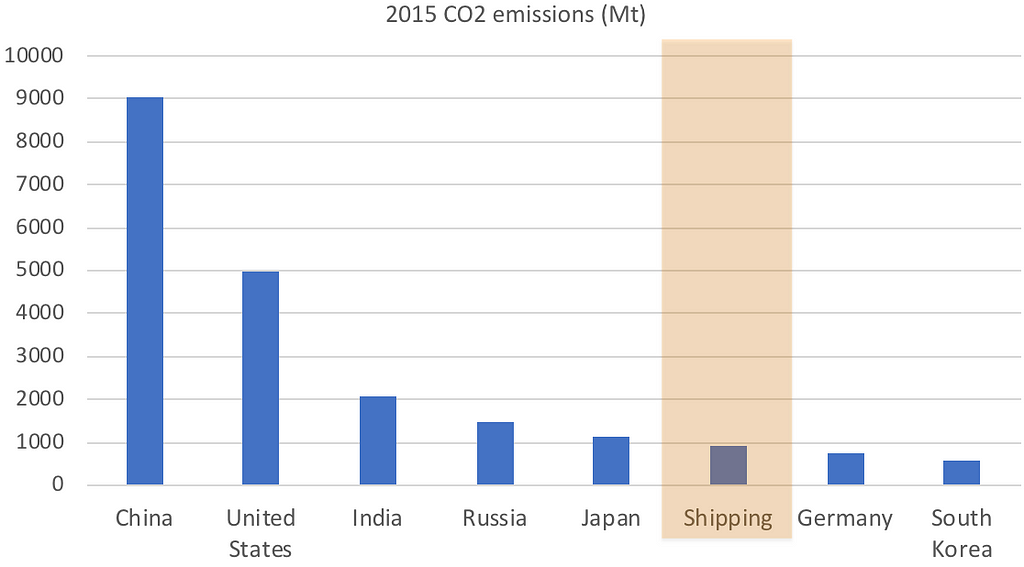
Here is another point of comparison: shipping emits about as much CO2 as the global aviation industry, but much less than road transport (~18% of manmade CO2 emissions). The graph below gives a visual comparison of emissions caused by different modes of transportation.
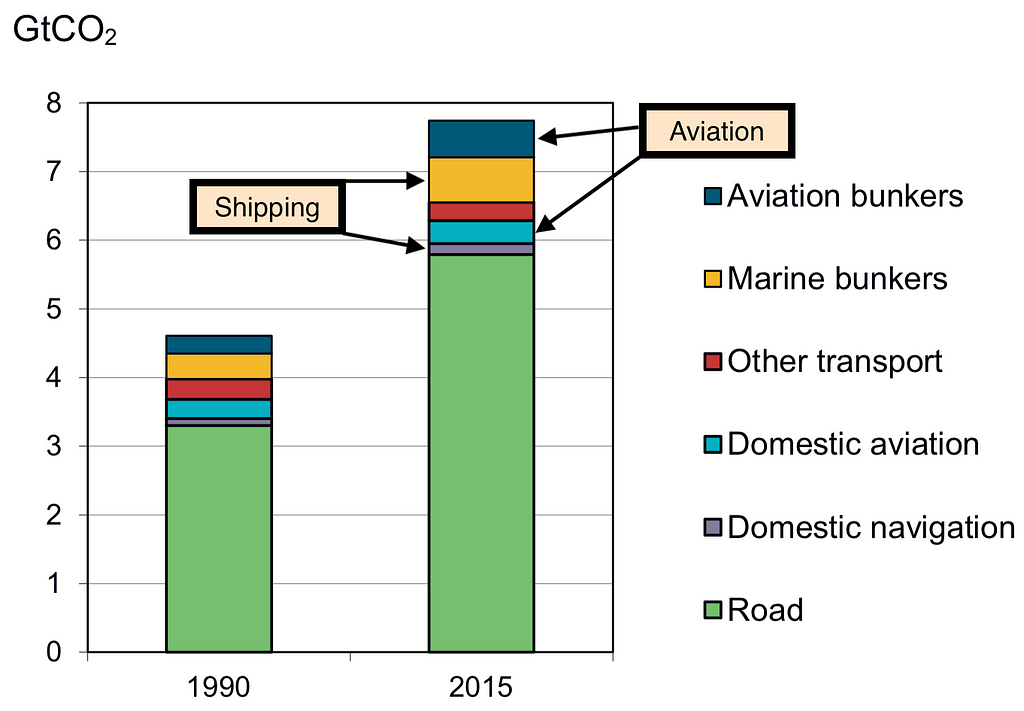
Interestingly, emissions from marine sources actually grew faster from 1990 to 2015 (+77%) than emissions from road transport. However, what strikes me the most is that ships contribute disproportionately more to SOx and NOx emissions (13 and 15% respectively) compared to CO2 emissions (2.6%).
So why is that?
The answer is fuel!
When one thinks of fuel, the first image that comes to mind is the liquid we pump daily at gas stations. However, the fuel used by ships has very little to do with the highly refined gasoline we pump into our cars. A picture being worth a thousand words, I present to you … bunker fuel!
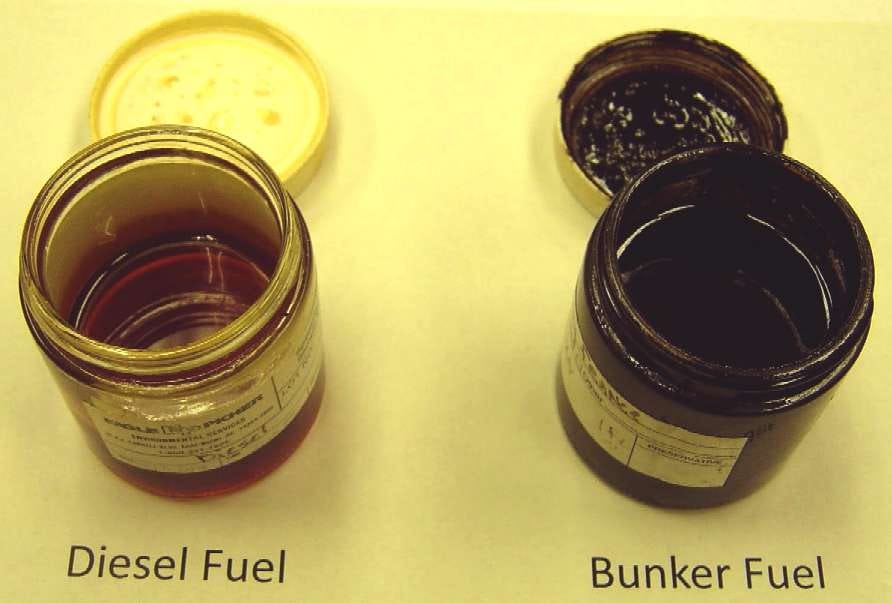
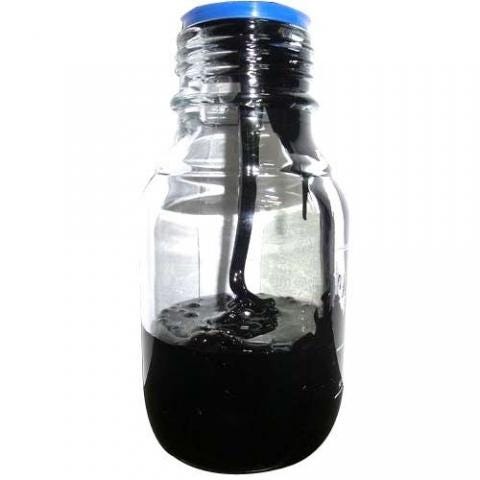
Bunker fuel (also called Heavy Fuel Oil) is the residue that drops to the bottom of the barrel. It’s called oil, but in reality it is so viscous that it is barely a liquid.
Actually it needs to be heated up just to be pumped into the ship’s engine since at room temperature the viscosity is too high for it to flow.
Bunker fuel has a concentration of sulphur that is about 3500 times higher than regular car gas. That’s why ships have such a high output of SOx and NOx compared to cars.
Usually ships use bunker fuel for their main engine (which are gigantic and can produce up to 100,000 hp) and they can burn up to 200 tons per day of fuel. This adds up to 73,000 tons of bunker fuel burnt per year for the biggest ships!
So you said some laws were passed right?
Yes! The International Maritime Organization (IMO) has a whole committee called the Marine Environment Protection Committee (MEPC) working on this. And actually on October 10 2008, they adopted what’s called the resolution MEPC.176(58) regulary dubbed the 2020 sulphur cap which provides guidelines on SOx emissions. Here’s the original decision:
The sulphur content of any fuel oil used on board ships shall not exceed the following limits:
1. 4.50% m/m (mass by mass) prior to 1 January 2012;
2. 3.50% m/m on and after 1 January 2012; and
3. 0.50% m/m on and after 1 January 2020.
So this looks pretty good and certainly like a step in the right direction. It means that sulphur content of bunker fuel will be reduced by almost 90% between 2011 and 2020.
Great! So adios SOx emissions. What about NOx though? To be honest, I’m not sure. I think that the refining processe required to reach the 0.5% sulphur cap will also reduce consequently nitrogen concentration but I would gladly get feedback on this.
Ok, now let’s talk CO2
When one talks air pollution, the most famous culprit is CO2. Interestingly, despite shipping’s large impact on CO2 emissions, the industry has been left out of the Paris Agreement on greenhouse gas reduction.
Talks regarding regulation of CO2 emissions in shipping date all the way back to 1997 but have stalled repeatedly. But at the beginning of April, the MEPC met again for its 72nd session in London and adopted its initial strategy for reducing greenhouse gas emissions.
The way the IMO works is that member states can make recommendations that are then debated by the committees. It is interesting to notice that the level of ambition varied wildly from country to country:
- The Marshall Islands have proposed that the IMO should aim for zero emissions by 2035 (which is significant because it comes from a leading flag state).
- EU member states including the UK are arguing for at least 70 percent reduction on 2008 emissions (and aiming for 100 percent) by 2050.
- Norway wants shipping to reduces its emissions by 50% towards 2050 compared to 2008.
- Finally, Japan has suggested that emissions be cut to 50% below 2008 levels by 2060.
In the end, the International Maritime Organization agreed to reduce emissions from global shipping by at least 50 percent from 2008 levels by 2050. This is a historic move that emerged out of very hard negotiations.
The road forward
This is great news for the planet, but the path forward will not be easy. Cutting down emissions this much will likely require large modifications of ships as well as operational changes.
At Shone we plan to develop advanced steering algorithms that allow ships to consume less fuel. This will be one more way to achieve those reductions and make a dent in global emissions. And I firmly believe that only a combination of changes in the operations of ships will allow the industry to reach its target!
If you’re interested in helping us make shipping greener, contact us!
The Hidden industry that pollutes more than the US and India was originally published in Shone Blog on Medium, where people are continuing the conversation by highlighting and responding to this story.